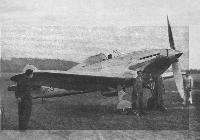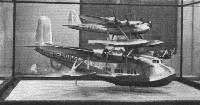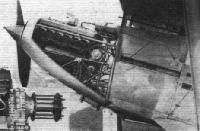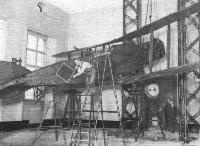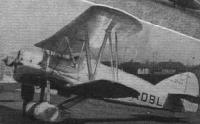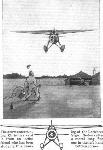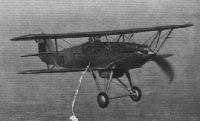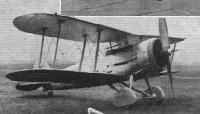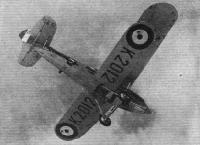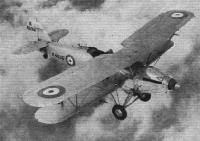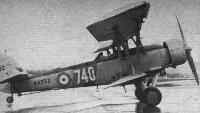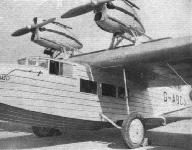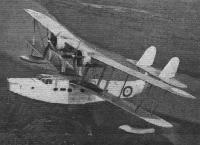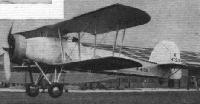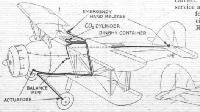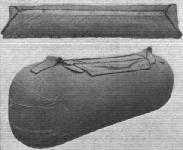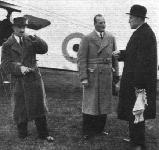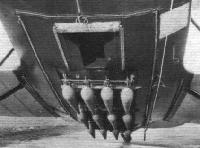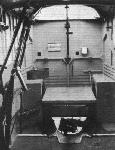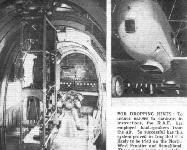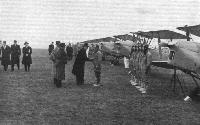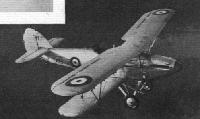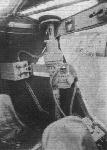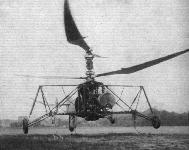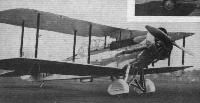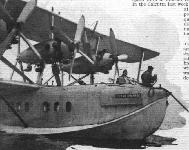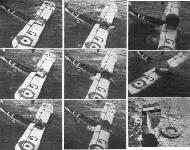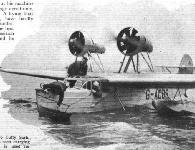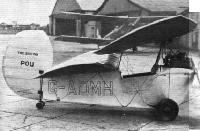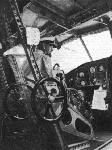Фотографии
-
Регистрационный номер: K5083 [4] STEEP AND SLOW: One outstanding feature of the Hawker Service types is their docility, which goes hand in hand with extreme performance. It may be assumed that a generous measure of that same "niceness" has been instilled into the new monoplane. The flaps, it will be seen from this Flight photograph, are of large area, and should steepen the glide considerably. Doubtless the somewhat "stilty" retractable undercarriage is accounted for by the immense airscrew used to absorb the terrific output of the Rolls Merlin.
Самолёты на фотографии: Hawker Hurricane - Великобритания - 1935
-
Регистрационный номер: K5083 [4] Самолёты на фотографии: Hawker Hurricane - Великобритания - 1935
-
Регистрационный номер: K5083 [4] Powered with a Rolls-Royce Merlin, the Hawker Hurricane has an extremely high performance. It has been adopted by the R.A.F.
Самолёты на фотографии: Hawker Hurricane - Великобритания - 1935
-
Регистрационный номер: K5083 [4] The prototype Hurricane being prepared for a test flight by Flt Lt Bulman at Brooklands in December 1935.
Самолёты на фотографии: Hawker Hurricane - Великобритания - 1935
-
Регистрационный номер: D-AQEX NIGHT MAIL: The scene on Croydon's tarmac a few minutes before ten o'clock. The D.L.H. freighter, a Ju. 52, is just about to leave on its nightly journey to Berlin. This service is run, winter and summer, with almost monotonous regularity.
Самолёты на фотографии: Junkers Ju.52/3m - Германия - 1931
-
Регистрационный номер: G-ADHJ [2], G-ADHK [2] IN MINIATURE : One of the many interesting exhibits at the Empire Airway Exhibition, which will be opened to-day, is this model of the Short-Mayo composite aeroplane.
Самолёты на фотографии: Short Mayo Composite (S.20 Mercury and S.21 Maia) - Великобритания - 1938
-
Регистрационный номер: G-ADHJ [2], G-ADHK [2] The new "big stuff'' represented by models. The Short-Mayo composite machine.
Самолёты на фотографии: Short Mayo Composite (S.20 Mercury and S.21 Maia) - Великобритания - 1938
-
The installation of a naturally aspirated Kestrel in a Hawker Hart.
Самолёты на фотографии: Hawker Hart - Великобритания - 1928
-
This series of sketches, specially prepared by Flight, shows the various types of gear and the flotation angles of certain R.A.F. machines. Those fitted with Youngman dinghies, of course, do not sink immediately.
Самолёты на фотографии: Fairey Swordfish - Великобритания - 1934Hawker Hart - Великобритания - 1928Hawker Nimrod - Великобритания - 1931Hawker Osprey - Великобритания - 1930Vickers Vildebeest / Type 132 - Великобритания - 1928
-
Регистрационный номер: G-ADWV APPROVED: Three Miles Hawk Trainers, a type which has now been approved for Air Ministry training, standing in front oi the new Phillips and Powis Reserve School buildings at Reading. With the modern tendency towards monoplanes for Service use, the approval was only logical.
Самолёты на фотографии: Miles Hawk / M.2 - Великобритания - 1932
-
Регистрационный номер: G-ACTD The modern trend in open types is illustrated in this type, the Miles Hawk Major.
Самолёты на фотографии: Miles Hawk / M.2 - Великобритания - 1932
-
Регистрационный номер: G-ACJL, G-ADLC, VH-UUF Two high-speed low-wing monoplanes, the Miles Falcon Six and the Airspeed Courier.
Самолёты на фотографии: Airspeed Courier / AS.5 - Великобритания - 1933Miles Falcon M.3 / Hawcon M.6 - Великобритания - 1934
-
Регистрационный номер: K5925 FOR HIGH-SPEED RESEARCH. The Miles Hawcon has been built specially for the Air Ministry in order to carry out high-speed research on thick wing sections. Wings of different thickness-chord ratios will be tested. The engine is a 200 h.p. Gipsy Six.
Самолёты на фотографии: Miles Falcon M.3 / Hawcon M.6 - Великобритания - 1934
-
ENSHRINING A "BRISFIT." This Bristol Fighter, "Biff" or "Brisfit," is one of a number of actual war-time aeroplanes now being transferred from Cardington to the new home of the Imperial War Museum, in the old Bethlem Hospital, Geraldine Mary Harmsworth Park, Southwark.
Самолёты на фотографии: Bristol F.2A/F.2B Fighter - Великобритания - 1916
-
Регистрационный номер: G-ADSR The new "big stuff'' represented by models. The Armstrong-Whitworth monoplane (which, incidentally, will be fitted with four Tiger VI's of 760 h.p.).
Самолёты на фотографии: Armstrong Whitworth Ensign / A.W.27 - Великобритания - 1938
-
Регистрационный номер: G-ADBL Armstrong Whitworth Scimitar (600 h.p. Panther).
Самолёты на фотографии: Armstrong Whitworth Scimitar / A.W.16 / A.W.35 - Великобритания - 1931
-
The Handley Page Heyford fitted with 600 h.p. Kestrel VI's.
Самолёты на фотографии: Handley Page Heyford / H.P.38 / H.P.50 - Великобритания - 1930
-
A standard medium bomber in the R.A.F., the Boulton Paul Overstrand (two Pegasus II M.) is fitted with the recently developed Boulton Paul gun turret.
Самолёты на фотографии: Boulton Paul Overstrand / P.75 - Великобритания - 1933
-
The above entertaining Christmas card is from an artist friend who has been studying this drawing of the Lockheed Vega. Seekers after a moral may find one in the left-hand bottom corner.
Самолёты на фотографии: Lockheed Vega - США - 1927
-
Hawker Fury (600 h.p. Kestrel VI).
Самолёты на фотографии: Hawker Fury - Великобритания - 1931
-
When this autogiro was delivered to the Fleet Air Arm for experimental carrier operation, an unusual type of flotation gear was fitted. Normally the spherical air bags are stowed in containers on the sides of the fuselage.
Самолёты на фотографии: Cierva/Avro C.30A / Rota - Великобритания - 1932
-
Gloster Gauntlet (605 h.p. Mercury VI S)
Самолёты на фотографии: Gloster Gauntlet - Великобритания - 1929
-
Регистрационный номер: K2012 The Hawker Audax (Kestrel IB or X) is intended for army co-operation.
Самолёты на фотографии: Hawker Audax - Великобритания - 1931
-
Регистрационный номер: K4636 With the 600 h.p. Kestrel V the Hawker Hind does about 200 m.p.h.
Самолёты на фотографии: Hawker Hind - Великобритания - 1934
-
WHERE'S THAT AIRFLOW? "Dishing it out" and "taking it" are the two main jobs of the Vought Corsair and, for that matter, of any naval aeroplane. This particular Corsair is not, for the moment, engaged in dishing anything out.
Самолёты на фотографии: Vought O2U/O3U/V-65/V-93 Corsair - США - 1926
-
Регистрационный номер: K4352 The first torpedo spotter reconnaissance machine to go into service with the R.A.F. is the Blackburn Shark (760 h.p. Tiger).
Самолёты на фотографии: Blackburn Shark / B-6 - Великобритания - 1933
-
Регистрационный номер: G-ABCJ The Saro Cloud shown there has two Napier Rapier engines. It is also available with two Siddeley Servals.
Самолёты на фотографии: Saunders-Roe Cloud / A.19 - Великобритания - 1930
-
A considerable number of Supermarine Stranraer flying boats with 820 h.p. Pegasus engines is to be built for the Royal Air Force.
Самолёты на фотографии: Supermarine Stranraer - Великобритания - 1934
-
The Supermarine Seagull V uses a Pegasus as a pusher installation.
Самолёты на фотографии: Supermarine Walrus/Seagull V - Великобритания - 1933
-
The Avro Anson coastal reconnaissance machine have been developed from civil type. The engines are Cheetah IXs.
Самолёты на фотографии: Avro Anson / Type 652 - Великобритания - 1935
-
Регистрационный номер: K4190 The Fairey Swordfish is also a T.S.R. and has been adopted for service. The engine is a 690 h.p. Pegasus III M.3.
Самолёты на фотографии: Fairey Swordfish - Великобритания - 1934
-
The atmospheric bag in the rear of the fuselage of the Fairey Swordfish T.S.R. machine
Самолёты на фотографии: Fairey Swordfish - Великобритания - 1934
-
This is the Youngman dinghy as fitted to the Fairey Swordfish torpedo spotter reconnaissance machine, now in production for the Fleet Air Arm.
Самолёты на фотографии: Fairey Swordfish - Великобритания - 1934
-
On the Fairey Swordfish T.S.R. there are unusual slinging arrangements. The two right-hand sketches show their layout, and in the first one, "broken" in its lower part, may be seen some of the details.
Самолёты на фотографии: Fairey Swordfish - Великобритания - 1934
-
The layout of the automatic and manual operation arrangements on the Fairey Swordfish may be seen in this Flight diagram. Note that in the Swordfish there is an emergency hand release in the tail. One actuator is always placed as far forward as possible, and its twin as low as convenient.
Самолёты на фотографии: Fairey Swordfish - Великобритания - 1934
-
A cockpit bag is carried on the Vickers Vildebeest torpedo bomber. It is normally stowed in the top portion of the fuselage but is inflated automatically when the Vildebeest enters the water
Самолёты на фотографии: Vickers Vildebeest / Type 132 - Великобритания - 1928
-
Регистрационный номер: K3583 The graceful Bristol 130 is another bomber transport and employs two moderately supercharged Pegasus radials.
Самолёты на фотографии: Bristol Bombay / Type 130 - Великобритания - 1935
-
D.W. Lucke in the machine which made the trip - the Ethyl Export Corporation's Rapide.
Самолёты на фотографии: De Havilland Dragon Rapide / Dominie / D.H.89 - Великобритания - 1934
-
Самолёты на фотографии: De Havilland Dragon Rapide / Dominie / D.H.89 - Великобритания - 1934
-
Viscount Swinton chatting, on arrival in a D.H.89, with Sqn. Ldr. Reid and Mr. George Lowdell (left), the chief instructor.
Самолёты на фотографии: De Havilland Dragon Rapide / Dominie / D.H.89 - Великобритания - 1934
-
Регистрационный номер: G-ADAO The Ethyl D.H. Rapide at Jodhpur.
Самолёты на фотографии: De Havilland Dragon Rapide / Dominie / D.H.89 - Великобритания - 1934
-
Risk of damage to the tail unit by the rear top gun is eliminated by this special guard. The two rear guns are of the Vickers drum-fed pattern.
Самолёты на фотографии: De Havilland Dragon Rapide / Dominie / D.H.89 - Великобритания - 1934
-
Twelve 27-lb. bombs are carried beneath the fuselage The opening seen in this view is for the bomb sight. The message hook is carried on the port side of the bomb racks.
Самолёты на фотографии: De Havilland Dragon Rapide / Dominie / D.H.89 - Великобритания - 1934
-
The D.H. 89 coastal reconnaissance machine have been developed from civil type. The engines are Gipsy Sixes.
Самолёты на фотографии: De Havilland Dragon Rapide / Dominie / D.H.89 - Великобритания - 1934
-
LUXURY PRIVATE OWNERSHIP. View of the interior of the D.H. 89 which the De Havilland Company has just completed for H. H. the Maharajah of Jammu and Kashmir. The view shows the "expanding" arm-rests which, while permitting gangway room, allow the occupants of the seats plenty of width when nobody is actually passing. The cabin is luxuriously upholstered - by Rumbolds - and all windows have blinds. The machine is finished in a biscuit shade.
Самолёты на фотографии: De Havilland Dragon Rapide / Dominie / D.H.89 - Великобритания - 1934
-
The top and bottom rear gun positions may be seen to advantage in this view. A special guard is provided for the top mounting to protect the tail unit from damage.
Самолёты на фотографии: De Havilland Dragon Rapide / Dominie / D.H.89 - Великобритания - 1934
-
LUXURY PRIVATE OWNERSHIP. View of the interior of the D.H. 89 which the De Havilland Company has just completed for H. H. the Maharajah of Jammu and Kashmir. Here is seen the rear portion of the cabin, containing a cocktail and luncheon cabinet. Also noticeable is one of the attachments for carrying sun helmets and, on the back of a seat, the step-ladder for entering the cabin.
Самолёты на фотографии: De Havilland Dragon Rapide / Dominie / D.H.89 - Великобритания - 1934
-
An amazing amount of military equipment, a great deal of which may be seen in this diagram, is ingeniously stowed away.
Самолёты на фотографии: De Havilland Dragon Rapide / Dominie / D.H.89 - Великобритания - 1934
-
A cleverly arranged framework to take four stretchers has been devised for the military Rapides. When not in use the whole gear folds away neatly.
Самолёты на фотографии: De Havilland Dragon Rapide / Dominie / D.H.89 - Великобритания - 1934
-
FOR DROPPING HINTS: To induce natives to conform to instructions, the R.A.F. has employed loud-speakers from the air. So successful has this system proved in Iraq that it is likely to be tried on the North-West Frontier and Somaliland. These views show an installation in a Vickers Valentia.
Самолёты на фотографии: Vickers Valentia - Великобритания - 1934
-
PRIMARY TRAINING. Viscount Swinton of Masham, our energetic Secretary of State for Air, inspecting a parade of instructors, pupils and Tiger Moths during his visit, last Friday, to the new Reid and Sigrist flying training school at Desford, near Leicester. This school is the ninth of the thirteen of its kind which are being introduced for the primary training of regular and reserve pilots of the R.A.F. under the expansion scheme.
Самолёты на фотографии: De Havilland Tiger Moth / D.H.82 - Великобритания - 1931
-
Регистрационный номер: G-ADIS Speed and comfort. The D.H. Hornet Moth, which has very comfortable seating for two side by side.
Самолёты на фотографии: De Havilland Hornet Moth / D.H.87 - Великобритания - 1934
-
The Fairey Hendon fitted with 600 h.p. Kestrel VI's.
Самолёты на фотографии: Fairey Hendon - Великобритания - 1930
-
A small fast monoplane. The Monospar Jubilee.
Самолёты на фотографии: General Aircraft Monospar ST-25 Universal - Великобритания - 1935
-
Регистрационный номер: A1-1 A number of specially equipped Demons (Kestrel V) have been supplied to Australia.
Самолёты на фотографии: Hawker Demon - Великобритания - 1932
-
The modern trend in cabin types is illustrated in this type, the Heston Phoenix
Самолёты на фотографии: Heston Phoenix - Великобритания - 1935
-
SCALED UP. This is the new Percival Vega Gull which was demonstrated at Gravesend last Thursday. Its fuselage and wing are larger than those of the standard Gull and there are four seats permitting side-by-side seating for two pairs of passengers. With a 200 h.p. Gipsy Six the maximum speed is 170 m.p.h. - perhaps rather more - and this fact, linked with the large capacity of the cabin, suits the machine for high speed charter work in addition to its function as an aerial saloon for private owners.
Самолёты на фотографии: Percival Vega Gull / K.1 - Великобритания - 1935
-
Самолёты на фотографии: Handley Page H.P.42 / H.P.45 - Великобритания - 1930
-
Регистрационный номер: G-AAXF Large commercial type: The Handley Page 42.
Самолёты на фотографии: Handley Page H.P.42 / H.P.45 - Великобритания - 1930
-
The Miles Merlin is in a lighter class, being a 4-5 seater.
Самолёты на фотографии: Miles Merlin / M.4 - Великобритания - 1935
-
The homing equipment which has been developed by Standard Telephones as it appears in the firm's own D.H. Puss Moth on which all tests have been made.
Самолёты на фотографии: De Havilland Puss Moth / D.H.80 - Великобритания - 1929
-
The R.C.5. direction finder installed in a Puss Moth.
Самолёты на фотографии: De Havilland Puss Moth / D.H.80 - Великобритания - 1929
-
Регистрационный номер: K3615 The Hawker Osprey is a two-seater fleet fighter with 600 h.p. Kestrel V engine.
Самолёты на фотографии: Hawker Osprey - Великобритания - 1930
-
On the Hawker Osprey the Youngman dinghy is carried in a box between the spars of the top starboard main plane. This view shows the complete installation of the box and the slinging gear in the centre section.
Самолёты на фотографии: Hawker Osprey - Великобритания - 1930
-
In this series of sketches may be seen what happens when a Hawker Osprey fitted with a Youngman dinghy is "ditched" - not that Osprey pilots make a habit of that sort of thing. This particular Osprey is in luck's way, for a salvage boat is soon on the scene.
Самолёты на фотографии: Hawker Osprey - Великобритания - 1930
-
The layout of the automatic and manual operation arrangements on the Hawker Osprey may be seen in this Flight diagram. One actuator is always placed as far forward as possible, and its twin as low as convenient.
Самолёты на фотографии: Hawker Osprey - Великобритания - 1930
-
Fhe Breguet gyroplane under test. Its wheels are clear of the ground but it is being held down by picket ropes
Самолёты на фотографии: Breguet-Dorand Gyroplane - Франция - 1933
-
A close-up view of the rotor head of the Breguet Gyroplane. The blades are carried on universal joints, and an incidence linkage is visible on the left.
Самолёты на фотографии: Breguet-Dorand Gyroplane - Франция - 1933
-
This photograph shows the internal construction of one of the rotor blades.
Самолёты на фотографии: Breguet-Dorand Gyroplane - Франция - 1933
-
Самолёты на фотографии: Westland Wallace / PV.3 / PV.6 - Великобритания - 1931
-
Регистрационный номер: VT-AFM Large commercial type: The Avro 642, is also available as a twin-engined machine
Самолёты на фотографии: Avro Type 642 - Великобритания - 1933
-
Регистрационный номер: G-ACKP A small fast monoplane. The D.H. Leopard Moth
Самолёты на фотографии: De Havilland Leopard Moth / D.H.85 - Великобритания - 1933
-
TRANS-PACIFIC: This sectioned drawing of the Martin China Clipper, which is reproduced by permission of our American contemporary, Aero Digest, clearly shows its layout as a passenger carrier. The position of the main fuel tanks is interesting.
Самолёты на фотографии: Martin China Clipper / Type 130 - США - 1934
-
Practical seamanship: The first Short Calcutta at its moorings in Southampton Water. In the forward hatch is Flt. Lt. Middleton, while Capt. Wilcockson, of Imperial Airways, is standing in the cockpit
Самолёты на фотографии: Short Calcutta / Rangoon / S.8 - Великобритания - 1928
-
TRAINING SHIP: A recent arrival at Air Service Training, Hamble, is a Short Calcutta flying boat on which Imperial Airways pilots will be instructed in readiness for duty on the Empire routes. Siddeley Tiger engines will eventually be installed. Major Brackley (superintendent of flying, Imperial Airways), who flew the machine from Rochester, is seen in this photograph with Flt. Lt. G. D. Middleton (left), one of the instructors.
Самолёты на фотографии: Short Calcutta / Rangoon / S.8 - Великобритания - 1928
-
A Nimrod which, fitted experimentally with wing flotation bags, has overturned on being "ditched." Nimrods do not normally carry the type of gear shown.
Самолёты на фотографии: Hawker Nimrod - Великобритания - 1931
-
This installation of atmospheric bags is in the Hawker Nimrod fleet fighter
Самолёты на фотографии: Hawker Nimrod - Великобритания - 1931
-
These views show how, on the machine being "ditched," the Youngman dinghy fitted to this Fairey IIIF bursts from its box - having been automatically inflated - and, as the aircraft sinks, gradually takes the weight. This particular IIIF has fuselage bags in addition to the dinghy.
Самолёты на фотографии: Fairey Fairey IIIF - Великобритания - 1926
-
A Short Scion
Самолёты на фотографии: Short Scion / S.16 - Великобритания - 1933
-
CROSS-CHANNEL: This is how the new Farman F.224 monoplanes now being built for Air France's London-Paris service will look when completed. One feature of outstanding interest is the forward cabin, which gives an unequalled view for a few lucky passengers. The undercarriages retract into the engine nacelles, which house four Gnome-Rhone Mistral Majors. The maximum speed is expected to be about 190 m.p.h.
Самолёты на фотографии: Farman/SNCAC NC.224 - Франция - 1937
-
The inverted twelve-cylinder water-cooled Farman engine of the Farman stratosphere monoplane. Part of the two-stage supercharger can be seen. The machine had a sealed and "supercharged" cabin. Unfortunately, before any decisive results were obtained, the Farman crashed while making a demonstration flight; apparently the pilot, M. Cogno, died during the flight, after attaining a height of 34,000 ft.
Самолёты на фотографии: Farman F.1000 - Франция - 1932
-
Регистрационный номер: G-ACDR [2] An amphibian has its advantages. The Cutty Sark descends the new slipway at Hamble while Flt. Lt. Middleton gives instructions from the control cabin. When the tide is out the "Cutty" can be landed on the aerodrome and taxied to its hangar.
Самолёты на фотографии: Saunders-Roe Cutty Sark / A.17 - Великобритания - 1929
-
Регистрационный номер: G-ACDR [2] Picking up moorings: The Saro Cutty Sark is used for preliminary training
Самолёты на фотографии: Saunders-Roe Cutty Sark / A.17 - Великобритания - 1929
-
The Saro Cutty Sark is seen carrying out some high-speed taxying
Самолёты на фотографии: Saunders-Roe Cutty Sark / A.17 - Великобритания - 1929
-
Регистрационный номер: G-ADMH A side view - note how the sides of the cockpit, previously open, have been filled in.
Самолёты на фотографии: Mignet Pou-de-Ciel / HM-14 - Франция - 1932
-
Mr. L. H. Sparey's Pou-du-Ciel - a model exhibiting many characteristics of the original.
Самолёты на фотографии: Mignet Pou-de-Ciel / HM-14 - Франция - 1932
-
Регистрационный номер: G-ADDB Open and closed. The one of two B.A. machines is the Swallow.
Самолёты на фотографии: British Klemm L.25 Swallow - Великобритания - 1933
-
Регистрационный номер: G-ACJJ MASTER PILOT: An impressive view of the pilot's cabin of the Short Scylla, with Capt. O. P. Jones at the controls. The next stage will, perhaps, involve a "bridge" ror the captain.
Самолёты на фотографии: Short Scylla / L.17 - Великобритания - 1934
-
SIDE-BY-SIDE AUTOGIRO SEATING: It is now possible to publish a photograph of the Westland-Lepere Autogiro, which is of the direct-control type and has a very wide wheel track to ensure stability on the ground. The engine is a 90 h.p. Pobjoy Niagara. The large expanse of transparent covering gives an excellent view from the cabin.
Самолёты на фотографии: Westland-Lepere CL-20 - Великобритания - 1935
-
Регистрационный номер: G-ADNL Speed and comfort. The Miles Sparrow-Hawk does 175 m.p.h.
Самолёты на фотографии: Miles Sparrowhawk / M.5 - Великобритания - 1935
Статьи
- Flight



